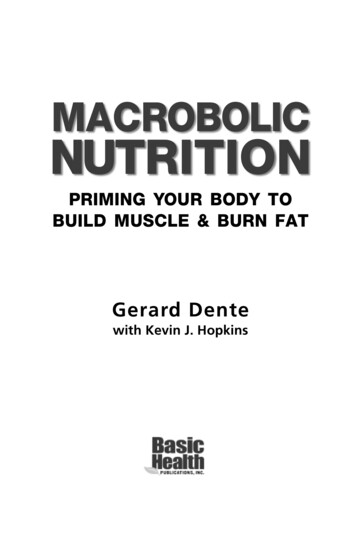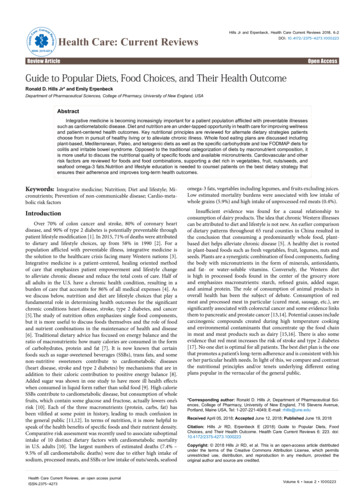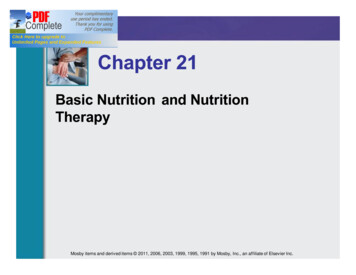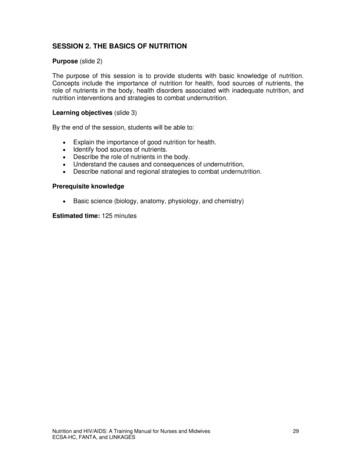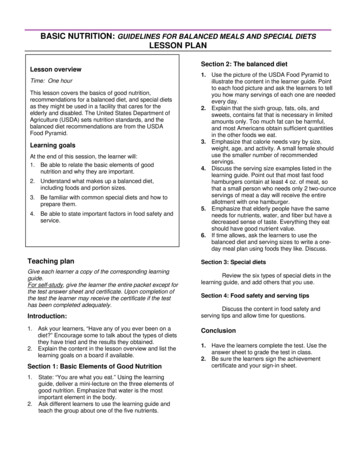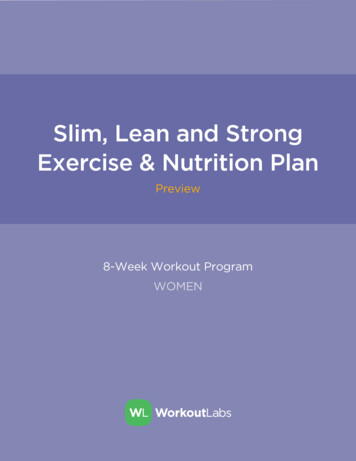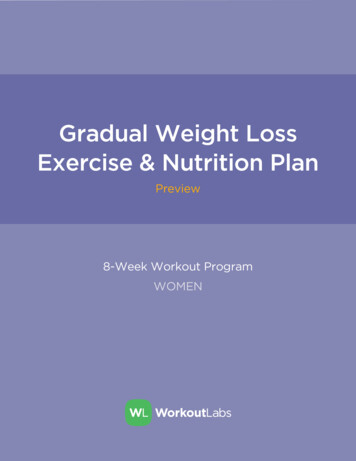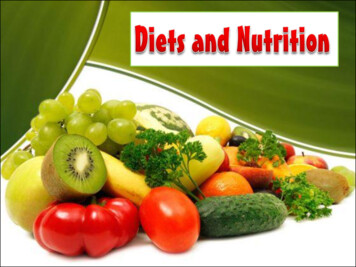
Transcription
Low-Carb dietsAtkins and South Beach: Both diets advocate severe carbohydrate reductioninitially, which promotes ketosis, and a gradual adding back of healthy unrefinedcarbs. Eating “all you want” of protein helps jump-start weight loss.Need to know: Clients who are doing “no carb” generally lose a good amount ofinitial (water) weight, but weight loss is temporary if the program is not followed aswritten. Dieters generally regain more weight than they lost when they return totheir normal diet.Special K dietThis diet suggests two out of three meals a day consist of a measured amount ofSpeical K with skim milk, with a third meal being a balanced, normal meal. Thereare no restrictions to snacks, coffee, or alcohol.Need to know: Because there is only one balanced meal a day, the diet is withinrecommended guidelines, but not advised to be carried on longer than two weeks.Very Low FatAn Ornish- or Pritikin-type diet does not focus on restricting calories, but ratherhow dense they are in any given food. The diet recommends eating foods high infiber and very low in fat and claims freedom to eat until you are full and neverhaving to be hungry in order to lose weight.Need to know: Fat helps with the feeling of fullness after a meal because it takelonger to digest. Those consuming extremely low-fat foods may find themselvesgrazing more because they are always hungry.
The Cookie DietIf it sounds too good to be true, question it. This diet is a low calorie diet,with dieters eating six “special” cookies throughout the day along with eightglasses of water. The cookies are designed to be meal replacements- madewith fiber, protein, and other ingredients intended to keep you full.Need to know: It recommends only 800 calories a day, and diets less than1,200 calories/day have issues in providing adequate nutrition.The 3-Hour Diet This diet recommends a strategy of eating smaller meals more frequently,approximately every 3 hours, to avoid distracting hunger pangs whilereducing calories. Staying fueled and hydrated helps the dieter maintainmotivation and energy.Need to know: You can modify any reduced-calorie diet into a 3-hour diet.Unfortunately, the 3-Hour Diet Web site states: “Lose Up to 10 Pounds in Just2 Weeks by Eating Every 3 Hours,” which is not recommended for permanentweight loss.The Blood Type Diet Dr. Peter D’Adamo advocates eating according to your genetic heritage.Depending on your ancestry (Caucasian, African, or Asian) and blood type (O,A, B, or AB), your diet includes highly beneficial foods to promote immunityand healthy weight.Need to know: The dieter is restricted to specific foods. However, all mealplans are balanced nutritionally, and the pattern of three meals and threesnacks helps the dieter combat diet fatigue.
Meal-replacement dietsSlim-Fast - an example of this type of diet - provides meal replacementproducts such as shakes and bars, to help people lose weight. It advisesusing Slim-Fast products for two meals and one snack daily. The rest of theday you are on your own to choose healthy meals when cooking or eatingout.Need to know: Dieters take in large amounts of artificial sweeteners andingredients. You must like the way the products taste or you won’t staywith the plan.Raw foods dietAdvocates of a raw foods or “living foods” diet say that cooking destroysimportant nutrients and enzymes, and that eating only raw, unprocessed,and unpasteurized foods will promote immunity and longevity.Need to know: Eating only uncooked foods is unnecessary for good health.Overcooking food depletes nutrients, but cooking is recommended forsafety reasons for meat, fish, and poultry. Cooking even enhances nutritionfor some foods, such as tomatoes.40/30/30Also known as the Zone diet, which suggested that eating about 40% ofcalories from carbohydrate and 30% each from fat and protein will helppeople stabilize blood glucose and lose weight.Need to know: The Zone diet does not recommend that you eat fewercalories than you're currently consuming, just different ones. The 40-30-30ratio applies to all meals all the time and can be complicated and scientific.
Those are Fad DietsThey might help you lose weight fast but do notlead to long term weight loss.Once you stop, you eventually re-gain what youlost and maybe more!
10 Easy Ways to Stay Healthy at School:1.2.3.Walk to class and use the stairsTake advantage of the Student Rec Center (you are paying for it!)Pick foods with fiber to help you stay full and snack on fruits andvegetables4. Watch your portions5. Eat breakfast and don’t skip meals6. Avoid eating when stressed, bored, or late at night7. Substitute soft drinks and juice with WATER8. Lay off the beer (alcohol is filled with empty calories)9. Sleep at least 8 hours a night10. Don’t smoke
Change the wayyou look at food!You've probably usedthe Food GuidePyramid as a way tolearn about healthyeating. Now the U.S.government hasreplaced the oldpyramid with a newsymbol: a plate.MyPlate is a food icon that serves asa powerful reminder to make healthyfood choices and to build a healthyplate at mealtimes.
Grains Meat/Protein– Give your brain and muscles energyand are a good source of B-vitaminsand iron.– Include whole grain bread, rice, pasta, andpotatoes at every meal. Fruits and Vegetables– Help build muscles, fight infection,and heal wounds.– Try having lean beef, chicken, peanutbutter, fish, tofu, or eggs at 2 meals daily. Milk/Dairy– Boost your immune system and are agood source of vitamins A and C,minerals, and fiber.– Help maintain strong bones andteeth. Are a good source of calciumand protein.– Try having apples, bananas, broccoli, carrots,squash, and salad 5 times per day or more.– Have a serving of low fat dairy foods like8-oz milk, 1-oz cheese, 1-cup yogurt orcottage cheese 3 times a day.Fats and Oils-Keep hair and skin soft and give a feeling of fullness.- Incorporate small amounts of "good" fats (monounsaturatedor polyunsaturated) into your daily diet: olive oil, corn oil, orcanola oil, and oil-rich foods like nuts, olives, and avocados.
ReadingANutritionLabel.
NetNutritionIf you like to keep track of your daily intake oncampus, check out NetNutrition!With NetNutrition you can: See nutrition facts for Ball State Dining menu items. Build meals around certain nutritional goals (such as the number of calories or fatgrams you want to consume in a day). Do side-by-side nutrition fact comparisons of different menu onInformation.aspxYou will find more links on the right side of the page to learn more about nutritioninformation, menus, snack meals, and more!
A, B, or AB), your diet includes highly beneficial foods to promote immunity and healthy weight. Need to know: The dieter is restricted to specific foods. However, all meal plans are balanced nutritionally, and the pattern of three meals and three snac

